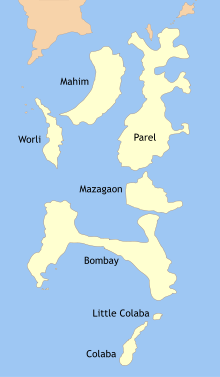Parel
| Parel परळ | |
|---|---|
| Neighbourhood | |
 Parel | |
| Coordinates: 18°59′N 72°50′E / 18.99°N 72.84°ECoordinates: 18°59′N 72°50′E / 18.99°N 72.84°E | |
| Country | India |
| State | Maharashtra |
| Metro | Mumbai |
| Demonym(s) | Parelkar |
| Language | |
| • Official | Marathi |
| Time zone | IST (UTC+5:30) |
| PIN | 400012[1] |
| Area code(s) | 022 |
| Vehicle registration | MH 01 |
| Civic agency | BMC |
| Lok Sabha constituency | Mumbai South |
| Vidhan Sabha constituency |
Worli (covers Lower Parel and surrounding areas) Shivadi (covers Parel, Lalbaug and surrounding areas) |
Parel or Lower Parel[2] is a neighbourhood of Mumbai. It lends its name to two railway stations (Parel and Lower Parel) on the Mumbai Suburban Railway. Parel West is also known as Elphinstone due to the Elphinstone Road railway station that lies in close proximity to the neighbourhood.
Many of the cotton mills in Mumbai and housing for their employees were in this area until the beginning of the 21st century when most of these mills were shut down. Lower Parel, which too was once dominated by textile mills till the 1980s, morphed into a posh locality as part of the redevelopment of Mumbai mills. The area is now dominated by luxury skyscraper apartments, upscale restaurants and pubs, premium office space, luxury hotels, and boutiques.

History

Originally Parel was a separate island, one of the Seven Islands of Bombay which were ceded by the Portuguese to England in 1661; it was linked up with the other islands in the 19th Century. In the 1770s, William Hornby, the Governor of Bombay, shifted his official residence to Parel. This area then became one of the poshest areas of the city. In 1867, tanners and dealers in dry fish were relocated in this area. By the 1870s, several cotton mills had been established in the reclaimed lands in Parel (West). Gradually, Paral became very polluted. In 1883, the Governor's wife died of cholera in the Government House. Two years later, the Governor's Mansion was moved to Malabar Point. During the plague epidemics of the 1890s, the old Government House was leased to the newly founded Haffkine Institute.[3] After the plague epidemics, mills proliferated in this area. In 1915, the Parel Bridge was built with linked the Western and Central Railway stations. It became an industrial area and in addition provided space for mill workers.[4]
References
- ↑ "Pin code : Parel, Mumbai". pincode.org.in. Retrieved 10 February 2015.
- ↑ D'Cunha, Jose Gerson (1900). "IV The Portuguese Period". The Origins of Bombay (3 ed.). Bombay: Asian Educational Services. p. 265. ISBN 81-206-0815-1. Retrieved 2009-01-04.
- ↑ Hanhart, Joël (2016). Waldemar Mordekhaï Haffkine (1860-1930). Biographie intellectuelle. Paris: Éditions Honoré Champion.
- ↑ Death of an Industrial City: Testimonies of Life Around Bombay Textile Strike of 1982Indian Labour Archives Archived May 6, 2006, at the Wayback Machine.
- Star Track; Times of India Mumbai; pg-2; 21 April 2006